Bing Zhang
Large Model Empowered Embodied AI: A Survey on Decision-Making and Embodied Learning
Aug 14, 2025Abstract:Embodied AI aims to develop intelligent systems with physical forms capable of perceiving, decision-making, acting, and learning in real-world environments, providing a promising way to Artificial General Intelligence (AGI). Despite decades of explorations, it remains challenging for embodied agents to achieve human-level intelligence for general-purpose tasks in open dynamic environments. Recent breakthroughs in large models have revolutionized embodied AI by enhancing perception, interaction, planning and learning. In this article, we provide a comprehensive survey on large model empowered embodied AI, focusing on autonomous decision-making and embodied learning. We investigate both hierarchical and end-to-end decision-making paradigms, detailing how large models enhance high-level planning, low-level execution, and feedback for hierarchical decision-making, and how large models enhance Vision-Language-Action (VLA) models for end-to-end decision making. For embodied learning, we introduce mainstream learning methodologies, elaborating on how large models enhance imitation learning and reinforcement learning in-depth. For the first time, we integrate world models into the survey of embodied AI, presenting their design methods and critical roles in enhancing decision-making and learning. Though solid advances have been achieved, challenges still exist, which are discussed at the end of this survey, potentially as the further research directions.
Hyperspectral Imaging
Aug 11, 2025Abstract:Hyperspectral imaging (HSI) is an advanced sensing modality that simultaneously captures spatial and spectral information, enabling non-invasive, label-free analysis of material, chemical, and biological properties. This Primer presents a comprehensive overview of HSI, from the underlying physical principles and sensor architectures to key steps in data acquisition, calibration, and correction. We summarize common data structures and highlight classical and modern analysis methods, including dimensionality reduction, classification, spectral unmixing, and AI-driven techniques such as deep learning. Representative applications across Earth observation, precision agriculture, biomedicine, industrial inspection, cultural heritage, and security are also discussed, emphasizing HSI's ability to uncover sub-visual features for advanced monitoring, diagnostics, and decision-making. Persistent challenges, such as hardware trade-offs, acquisition variability, and the complexity of high-dimensional data, are examined alongside emerging solutions, including computational imaging, physics-informed modeling, cross-modal fusion, and self-supervised learning. Best practices for dataset sharing, reproducibility, and metadata documentation are further highlighted to support transparency and reuse. Looking ahead, we explore future directions toward scalable, real-time, and embedded HSI systems, driven by sensor miniaturization, self-supervised learning, and foundation models. As HSI evolves into a general-purpose, cross-disciplinary platform, it holds promise for transformative applications in science, technology, and society.
Strategic priorities for transformative progress in advancing biology with proteomics and artificial intelligence
Feb 21, 2025

Abstract:Artificial intelligence (AI) is transforming scientific research, including proteomics. Advances in mass spectrometry (MS)-based proteomics data quality, diversity, and scale, combined with groundbreaking AI techniques, are unlocking new challenges and opportunities in biological discovery. Here, we highlight key areas where AI is driving innovation, from data analysis to new biological insights. These include developing an AI-friendly ecosystem for proteomics data generation, sharing, and analysis; improving peptide and protein identification and quantification; characterizing protein-protein interactions and protein complexes; advancing spatial and perturbation proteomics; integrating multi-omics data; and ultimately enabling AI-empowered virtual cells.
UrbanSAM: Learning Invariance-Inspired Adapters for Segment Anything Models in Urban Construction
Feb 21, 2025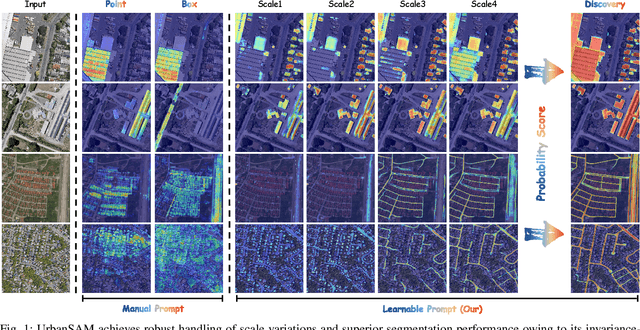

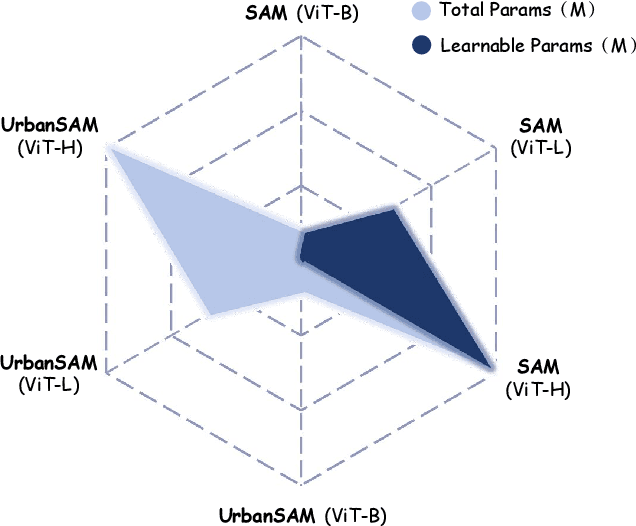
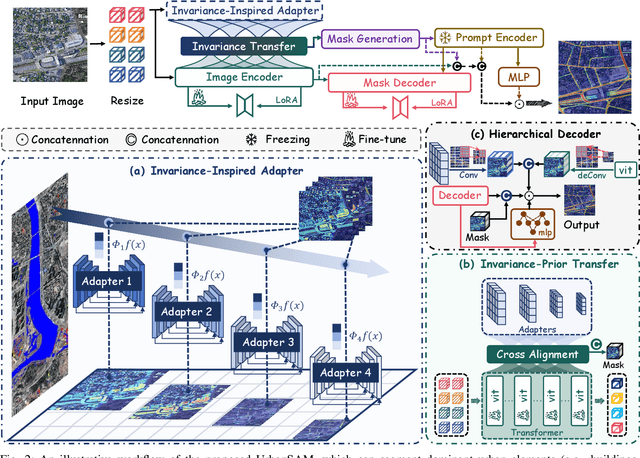
Abstract:Object extraction and segmentation from remote sensing (RS) images is a critical yet challenging task in urban environment monitoring. Urban morphology is inherently complex, with irregular objects of diverse shapes and varying scales. These challenges are amplified by heterogeneity and scale disparities across RS data sources, including sensors, platforms, and modalities, making accurate object segmentation particularly demanding. While the Segment Anything Model (SAM) has shown significant potential in segmenting complex scenes, its performance in handling form-varying objects remains limited due to manual-interactive prompting. To this end, we propose UrbanSAM, a customized version of SAM specifically designed to analyze complex urban environments while tackling scaling effects from remotely sensed observations. Inspired by multi-resolution analysis (MRA) theory, UrbanSAM incorporates a novel learnable prompter equipped with a Uscaling-Adapter that adheres to the invariance criterion, enabling the model to capture multiscale contextual information of objects and adapt to arbitrary scale variations with theoretical guarantees. Furthermore, features from the Uscaling-Adapter and the trunk encoder are aligned through a masked cross-attention operation, allowing the trunk encoder to inherit the adapter's multiscale aggregation capability. This synergy enhances the segmentation performance, resulting in more powerful and accurate outputs, supported by the learned adapter. Extensive experimental results demonstrate the flexibility and superior segmentation performance of the proposed UrbanSAM on a global-scale dataset, encompassing scale-varying urban objects such as buildings, roads, and water.
Cloud Removal With PolSAR-Optical Data Fusion Using A Two-Flow Residual Network
Jan 14, 2025Abstract:Optical remote sensing images play a crucial role in the observation of the Earth's surface. However, obtaining complete optical remote sensing images is challenging due to cloud cover. Reconstructing cloud-free optical images has become a major task in recent years. This paper presents a two-flow Polarimetric Synthetic Aperture Radar (PolSAR)-Optical data fusion cloud removal algorithm (PODF-CR), which achieves the reconstruction of missing optical images. PODF-CR consists of an encoding module and a decoding module. The encoding module includes two parallel branches that extract PolSAR image features and optical image features. To address speckle noise in PolSAR images, we introduce dynamic filters in the PolSAR branch for image denoising. To better facilitate the fusion between multimodal optical images and PolSAR images, we propose fusion blocks based on cross-skip connections to enable interaction of multimodal data information. The obtained fusion features are refined through an attention mechanism to provide better conditions for the subsequent decoding of the fused images. In the decoding module, multi-scale convolution is introduced to obtain multi-scale information. Additionally, to better utilize comprehensive scattering information and polarization characteristics to assist in the restoration of optical images, we use a dataset for cloud restoration called OPT-BCFSAR-PFSAR, which includes backscatter coefficient feature images and polarization feature images obtained from PoLSAR data and optical images. Experimental results demonstrate that this method outperforms existing methods in both qualitative and quantitative evaluations.
RSGaussian:3D Gaussian Splatting with LiDAR for Aerial Remote Sensing Novel View Synthesis
Dec 24, 2024



Abstract:This study presents RSGaussian, an innovative novel view synthesis (NVS) method for aerial remote sensing scenes that incorporate LiDAR point cloud as constraints into the 3D Gaussian Splatting method, which ensures that Gaussians grow and split along geometric benchmarks, addressing the overgrowth and floaters issues occurs. Additionally, the approach introduces coordinate transformations with distortion parameters for camera models to achieve pixel-level alignment between LiDAR point clouds and 2D images, facilitating heterogeneous data fusion and achieving the high-precision geo-alignment required in aerial remote sensing. Depth and plane consistency losses are incorporated into the loss function to guide Gaussians towards real depth and plane representations, significantly improving depth estimation accuracy. Experimental results indicate that our approach has achieved novel view synthesis that balances photo-realistic visual quality and high-precision geometric estimation under aerial remote sensing datasets. Finally, we have also established and open-sourced a dense LiDAR point cloud dataset along with its corresponding aerial multi-view images, AIR-LONGYAN.
Multisource Collaborative Domain Generalization for Cross-Scene Remote Sensing Image Classification
Dec 05, 2024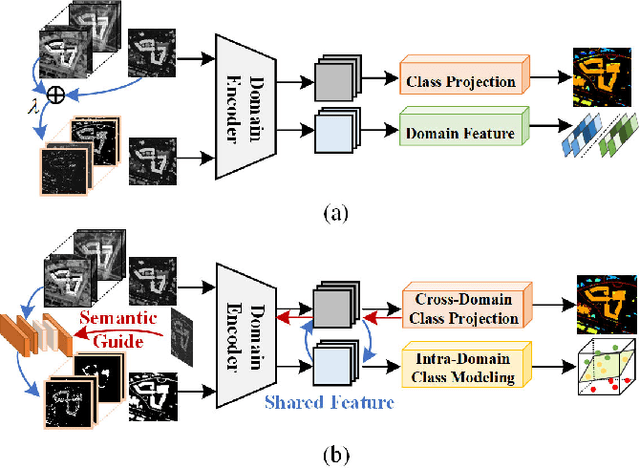
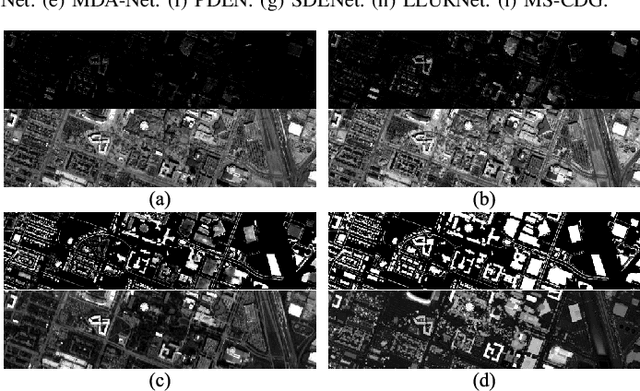

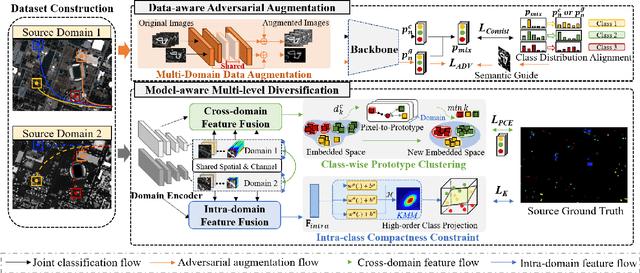
Abstract:Cross-scene image classification aims to transfer prior knowledge of ground materials to annotate regions with different distributions and reduce hand-crafted cost in the field of remote sensing. However, existing approaches focus on single-source domain generalization to unseen target domains, and are easily confused by large real-world domain shifts due to the limited training information and insufficient diversity modeling capacity. To address this gap, we propose a novel multi-source collaborative domain generalization framework (MS-CDG) based on homogeneity and heterogeneity characteristics of multi-source remote sensing data, which considers data-aware adversarial augmentation and model-aware multi-level diversification simultaneously to enhance cross-scene generalization performance. The data-aware adversarial augmentation adopts an adversary neural network with semantic guide to generate MS samples by adaptively learning realistic channel and distribution changes across domains. In views of cross-domain and intra-domain modeling, the model-aware diversification transforms the shared spatial-channel features of MS data into the class-wise prototype and kernel mixture module, to address domain discrepancies and cluster different classes effectively. Finally, the joint classification of original and augmented MS samples is employed by introducing a distribution consistency alignment to increase model diversity and ensure better domain-invariant representation learning. Extensive experiments on three public MS remote sensing datasets demonstrate the superior performance of the proposed method when benchmarked with the state-of-the-art methods.
Dual-Branch Subpixel-Guided Network for Hyperspectral Image Classification
Dec 05, 2024



Abstract:Deep learning (DL) has been widely applied into hyperspectral image (HSI) classification owing to its promising feature learning and representation capabilities. However, limited by the spatial resolution of sensors, existing DL-based classification approaches mainly focus on pixel-level spectral and spatial information extraction through complex network architecture design, while ignoring the existence of mixed pixels in actual scenarios. To tackle this difficulty, we propose a novel dual-branch subpixel-guided network for HSI classification, called DSNet, which automatically integrates subpixel information and convolutional class features by introducing a deep autoencoder unmixing architecture to enhance classification performance. DSNet is capable of fully considering physically nonlinear properties within subpixels and adaptively generating diagnostic abundances in an unsupervised manner to achieve more reliable decision boundaries for class label distributions. The subpixel fusion module is designed to ensure high-quality information fusion across pixel and subpixel features, further promoting stable joint classification. Experimental results on three benchmark datasets demonstrate the effectiveness and superiority of DSNet compared with state-of-the-art DL-based HSI classification approaches. The codes will be available at https://github.com/hanzhu97702/DSNet, contributing to the remote sensing community.
Hyperspectral Image Cross-Domain Object Detection Method based on Spectral-Spatial Feature Alignment
Nov 25, 2024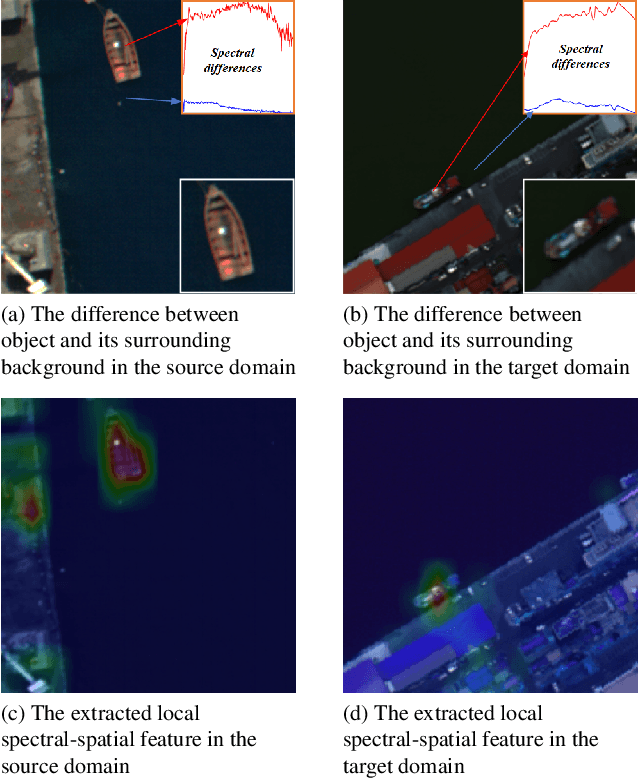

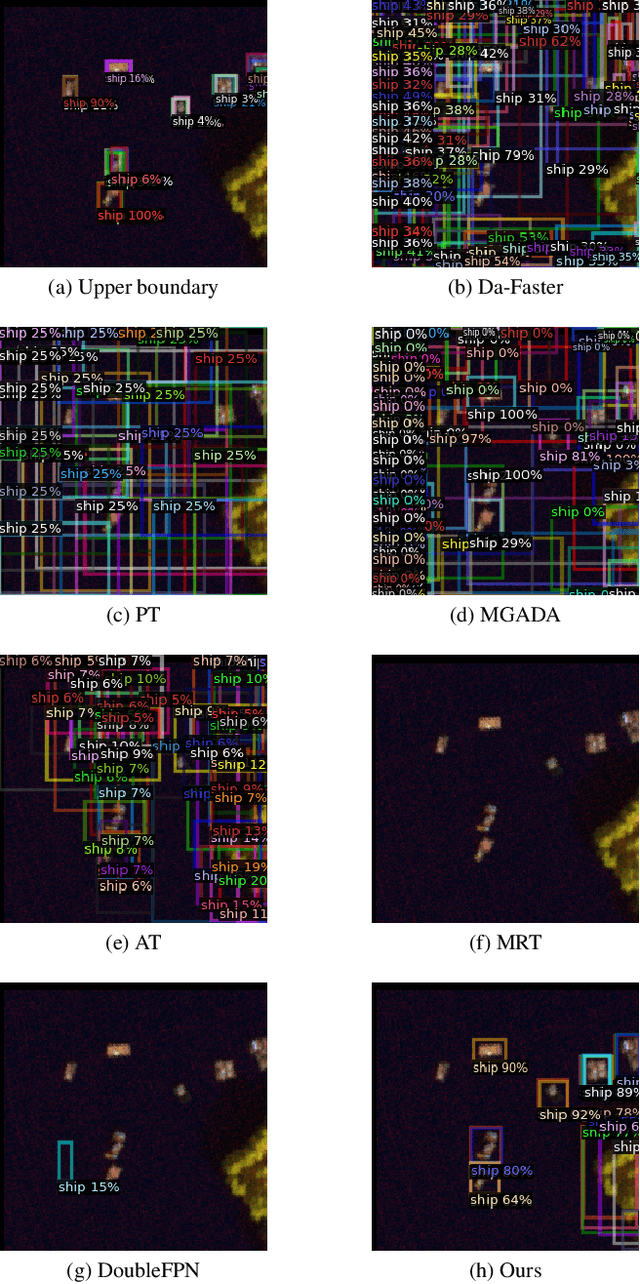

Abstract:With consecutive bands in a wide range of wavelengths, hyperspectral images (HSI) have provided a unique tool for object detection task. However, existing HSI object detection methods have not been fully utilized in real applications, which is mainly resulted by the difference of spatial and spectral resolution between the unlabeled target domain and a labeled source domain, i.e. the domain shift of HSI. In this work, we aim to explore the unsupervised cross-domain object detection of HSI. Our key observation is that the local spatial-spectral characteristics remain invariant across different domains. For solving the problem of domain-shift, we propose a HSI cross-domain object detection method based on spectral-spatial feature alignment, which is the first attempt in the object detection community to the best of our knowledge. Firstly, we develop a spectral-spatial alignment module to extract domain-invariant local spatial-spectral features. Secondly, the spectral autocorrelation module has been designed to solve the domain shift in the spectral domain specifically, which can effectively align HSIs with different spectral resolutions. Besides, we have collected and annotated an HSI dataset for the cross-domain object detection. Our experimental results have proved the effectiveness of HSI cross-domain object detection, which has firstly demonstrated a significant and promising step towards HSI cross-domain object detection in the object detection community.
Enterprise Benchmarks for Large Language Model Evaluation
Oct 11, 2024



Abstract:The advancement of large language models (LLMs) has led to a greater challenge of having a rigorous and systematic evaluation of complex tasks performed, especially in enterprise applications. Therefore, LLMs need to be able to benchmark enterprise datasets for various tasks. This work presents a systematic exploration of benchmarking strategies tailored to LLM evaluation, focusing on the utilization of domain-specific datasets and consisting of a variety of NLP tasks. The proposed evaluation framework encompasses 25 publicly available datasets from diverse enterprise domains like financial services, legal, cyber security, and climate and sustainability. The diverse performance of 13 models across different enterprise tasks highlights the importance of selecting the right model based on the specific requirements of each task. Code and prompts are available on GitHub.
 Add to Chrome
Add to Chrome Add to Firefox
Add to Firefox Add to Edge
Add to Edge